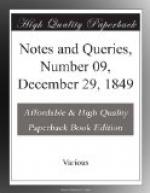E.F.R.
* * * * *
ANCIENT INSCRIBED DISHES.
Judging from the various notices in your Nos. 3, 5, and 6, the dishes and inscriptions mentioned therein by CLERICUS, L.S.B., &c., pp. 44. 73. 87., are likely to cause as much speculation here as they have some time experienced on the continent. They were there principally figured and discussed in the Curiositaten, a miscellaneous periodical, conducted from about 1818 to 1825, by Vulpius, brother-in-law of Goethe, librarian to the Grand Duke of Saxe Weimar. Herr v. Strombeck, Judge of the Supreme Court of Appeal at Wolfenbuettel, first noticed them from a specimen belonging to the church of a suppressed convent at Sterterheim near Brunswick, and they were subsequently pounced upon by Joseph v. Hammer (now v. Purgstall), the learned orientalist of Vienna, as one of the principal proofs which he adduced in his Mysterium Baphometis Revelatum in one of the numbers of the Fundgruben (Mines) des Orients, for the monstrous impieties and impurities which he, Nicolai, and others, falsely attributed to the Templars. Comments upon these dishes occur in other works of a recent period, but having left my portfolio, concerning them, with other papers, on the continent, I give these hasty notices entirely from memory. They are by no means uncommon now in England, as the notices of your correspondents prove. A paper on three varieties of them at Hull was read in 1829, to the Hull Literary and Philosophical Society. In Nash’s Worcestershire one is depicted full size, and a reduced copy given about this period in the Gentleman’s Magazine, and Nash first calls them “Offertory Dishes.” The Germans call them Taufbecken, or baptismal basins; but I believe the English denomination more correct, as I have a distinct recollection of seeing, in a Catholic convent at Danzig, a similar one placed on Good Friday before the tomb of the interred image of the Saviour, for the oblations for which it was not too large. Another of them is kept upon the altar of Boroughbridge Church (N. Riding of Yorkshire), but sadly worn down by scrubbing to keep it bright, and the attempt at a copy of the Inscription in a Harrowgate Guide is felicitously ludicrous: it is there taken as a relic of the Roman Isurium on the same spot. Three others were observed some years ago in a neglected nook of the sacristy of York Cathedral. At the last meeting of the Institute at Salisbury, a number of these were exhibited in St. John’s House there, but I believe without any notice taken of them in its Proceedings; and another was shown to the Archaeological Society, at their last Chester Congress, by Colonel Biddulph, at Chirk Castle; when more were mentioned by the visitors as in their possession, anxious as your correspondents to know the import of the inscriptions. They are sometimes seen exposed in the shops of Wardour Street, and in other curiosity shops of the metropolis.




